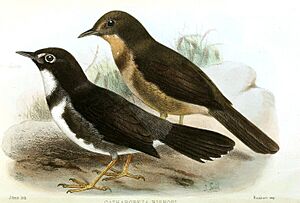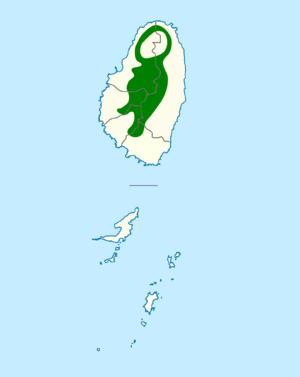Whistling warbler facts for kids
Quick facts for kids Whistling warbler |
|
|---|---|
 |
|
| Conservation status | |
| Scientific classification | |
| Genus: |
Catharopeza
|
| Species: |
bishopi
|
 |
|
| Synonyms | |
|
|
The whistling warbler (Catharopeza bishopi) is a small bird from the New World warbler family. It is the only species in its group, called a monotypic genus. This bird has a dark back that gets lighter towards its chest. It also has a dark head, a dark stripe on its chest, and a light ring around its eyes. Both male and female whistling warblers look the same.
This special bird lives only on the island of Saint Vincent in the Lesser Antilles. It likes to live in warm, wet forests and mountain forests. Sadly, the whistling warbler is in danger because it is losing its home. This happens because of volcanoes and trees being cut down. Whistling warblers build cup-shaped nests and lay spotted eggs. They mostly eat insects.
Contents
Whistling Warbler's Family Tree
The whistling warbler's scientific name has changed over time. It was first called Leucopeza bishopi. Later, scientists changed it to Catharopeza bishopi. This change happened because the bird's body shape, like its strong build, was different from other birds in the Leucopeza group.
Scientists have different ideas about which bird is the whistling warbler's closest relative. Some studies suggest it's a bird called Phaeothlypis. They say the whistling warbler's way of finding food, its body shape, and its song are more like Phaeothlypis. Other studies show that Dendroica birds are its closest relatives. Many experts agree that Dendroica and Catharopeza are closely related. They are often placed next to each other in bird classifications because they look and sound similar. One study even found that the Dendroica plumbea species is the closest relative within the Dendroica group.
What Does a Whistling Warbler Look Like?
The whistling warbler is often compared to a wren because of how it looks. It has feathers that are a dusty-black color. Its head and beak are dark. Some people have described its feathers as medium-brown.
A bright white ring goes around its eye, and its eye itself is hazel. It also has a small amount of off-white color on its chin. The tips of the feathers on its upper throat are also off-white. Its chest has a pattern that looks like black and white stripes. The black part is between two white bands. The underside of its tail changes color from a blackish-gray to an off-white. The two feathers at the very end of its tail have a white triangle shape. The bird's legs and toes are a light orange color. Both male and female whistling warblers have the same beautiful feathers.
Whistling warblers are about 5 ½ to 5 ¾ inches long. Their wings are around 2 ¾ inches long, and their tail is about 2 ½ inches long. Their legs are about 7/8 inches long, and their wingspan is around 8 ½ inches wide.
Young whistling warblers look a bit different. They have black feathers growing on the top of their head. Their tail feather tips look like the adults', but the rest of their tail feathers are black. The top part of their body is a dark greenish-brown, and the bottom part is lighter. Instead of the white marks that adults have, young birds have light reddish-brown marks. Their flight feathers are brown.
The whistling warbler's song is fast and gets louder. It sounds a bit like the Troglodytes rufescen bird, but with less variety. Its call is compared to a weaker olive-backed thrush song. In a study from 1986, scientists found that the most common songs lasted about 4 to 6 seconds. They also heard the whistling warbler singing from morning until late afternoon, unless it was raining heavily.
Where Whistling Warblers Live
Whistling warblers live in the hills and mountains of St. Vincent island. This includes places like Richmond Peak and Grand Bonhomme. St. Vincent is about 18 miles long. It is located at 13 degrees 10 minutes north latitude and 60 degrees 57 minutes west longitude. The island has both active and inactive volcanoes.
The hilltops where these birds live do not have a dry season. They are considered rainforests because they get about 3800 mm of rain each year. These rainforests are found at elevations from 300 meters to 500 meters high.
The areas where whistling warblers live have changed over time. Before a volcano erupted in 1902, they were usually found around 300 meters above sea level. Now, they are found in areas from 300 meters to 600 meters high. More of them are found at lower elevations. This is because there are more ravines, gorges, and valleys in those lower areas. The higher altitudes have more wet slopes.
Whistling Warbler Behavior and Life Cycle
Reproduction
Whistling warblers build cup-shaped nests. These nests are usually found at low heights. Scientists have seen spotted eggs in their nests. One observation showed nesting happening in July, and another in April. Chicks with developed wings, only a few days to a week old, have been seen outside the nest.
Diet and Foraging
Whistling warblers usually look for food at low heights. They forage from the ground up to 4 meters high, and sometimes up to 15 meters. They can be seen searching for food on large rocks near streams, on big boulders, and on old, decaying logs. They eat insects, parts of plants, and sometimes even small lizards.
When they are looking for food, they hop from branch to branch. They often hold their tail in a "cocked" or slightly raised position. The whistling warbler will quickly flick this "cocked tail" when it is observed foraging.
Whistling Warbler's Status
The whistling warbler is listed as endangered by the IUCN Red List. This means it is at high risk of disappearing forever. It is in danger because its home is shrinking and its numbers are going down.
Scientists believe there are only about 3,000 to 5,000 whistling warblers left in the wild. Some parts of their remaining home are hard for humans to reach. This helps protect them a little. However, they are very vulnerable to volcanic eruptions. Mount Soufriére has erupted twice since the year 1900. Both volcanic activity and cutting down trees for sugarcane have reduced the whistling warbler's population by about half. The birds have started to move back into the Le Soufriére area. They now live in an area of about 90 square kilometers.


